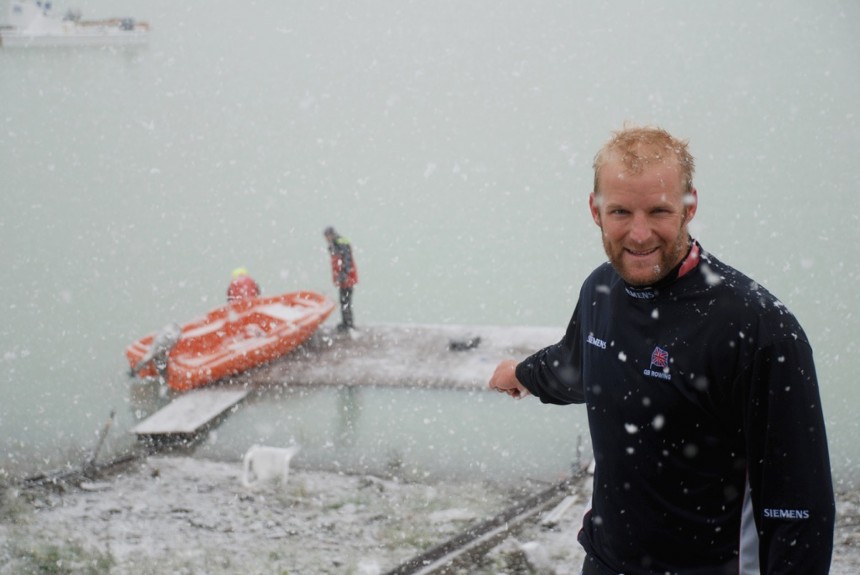
February 19, 2019
Four Seasons: The Outdoor Life of an Olympian
Brutal routines in a beautiful place
By Tom Ransley
The training program is a document of order; a meticulous plan. It is a series of precise instructions detailing modality, distance, speed and location. The chaos of life never breaches the sacrosanct world of the ‘training program.’ Weddings and funerals alike are impervious to its planned pattern of perfection. It resides within virtual boundaries isolated in an excel spreadsheet. The training program never shivers in the cold or burns in the heat. Those experiences are exclusive to the rowers. It is their job to give life to the training program. They live it, do it and make it real.
The program derives from science and method, built upon decades’ worth of observations, calculations, and analysis. All of this is directed towards a single point in the future — the Olympic Games. Years of preparation prescribed, all leading to a single race. The program is obsessed by Olympic competition. However, unlike the training program, Olympic competition is a world of instinct, aggression and uncertainty. Training camp is where these two worlds begin to merge. Disparate, ferocious power is ordered into smooth consistent harmony. The program seeks better boat speed: camp is where we find it.
Having trained and raced for Great Britain for a decade I have given life to the training program in all manner of conditions, time zones and countries. One of our longstanding training camp venues is high up in the Austrian Alps, a place where cow bells are the first sound in the morning and the last sound at night. It is probably my favorite place to prepare for a big competition. There is an inherent hardy nature to the place and the environment imbues a toughness that suits our discipline. In many ways it defies modern elite-sports centers that adhere to every detail of sports science. It isn’t clean or clinical, it doesn’t have expensive shiny equipment.
The local garage becomes our makeshift gym. The bench press is a rough plank of wood lashed down with boat ties to two metal boxes. The weights are dirty and rusted and they ruin lifting vests; anyone snaking the reps are called out by the lack of grime upon their person. The team drag all of this equipment out of a dank dark basement, where it has rotted for a year since the last time we were there. The mats are barely intact and provide little to no cushioning, but they are a tangible reminder of those that have gone before. They are objects of history, a collective physical incarnation of the past — or if nothing else, they strengthen the immune system as you collapse face down onto decades worth of previous exertions.
The mountain location provides a raw and savage beauty in which to endure a brutal fortnight. Mountains have always presented humans with an alluring challenge. A place in which to conquer oneself, it can be an unforgiving environment. The altitude provides an additional level of stress on the body. The air at altitude will provide less oxygen to the body compared to sea level, owing to the difference in partial pressure. It’s a tough place to train, but it can be rewarding. The isolation yields increased concentration. Sweeping the boat along alpine waters, 2000m above sea level, surrounded by snowy vistas is both peaceful and profound.
Of course, not every session is so serene nor feels so glorious. We are forever at the mercy of the changeable mountain weather. Within a single session the conditions can flip through all four seasons. When the thunder and lightning rage, we submit to the mountain and get off its lake, but only to the sore comfort of an indoor rowing machine.
During these camps I spend a lot of time staring at food. The altitude also seems to ward off any sort of appetite. Eating becomes a war of attrition — an unfortunate side effect as a lot of calories are needed to replace those expended rowing. Thursday lunchtimes are the worst: the program requires an all-out effort on the rowing machine. It won’t be the only session of the day, but certainly the toughest. Afterwards I will peel myself off the garage floor and head to the cafe. Despite the friendly staff, I rarely force all the food down. Instead I pick and prod at it, until it becomes a formless mush, staring at the plate as if hoping to achieve some nutritional sustenance via the power of sight. We aim to consume around six thousand calories a day but this isn’t always possible. Weight loss is common amongst the squad during this camp.
Pushing at the limits and testing one’s physical and mental capability are essential to elite sport, but the pursuit of high-level success comes with a significant risk of injury and illness. There is only a thin line between peak fitness and injury and it is easily crossed. Managing a high-performance program can feel as if one teeters daily on a knife edge, forever judging how much is too much. Getting the best from the training requires a careful balancing act. It’s uncomfortable, but the path to success is rarely comfortable. As Lewis et al state in their paper on unexplained underperformance syndrome: “Peaking at major championships is a challenge, and training capacity is highly individual, with fine margins between the training dose necessary for adaptation and that which elicits maladaptation at the elite level.” Despite the stress and the risk of injury it is an honor to represent Great Britain and a privilege to be one of those still breathing life into the training program.





